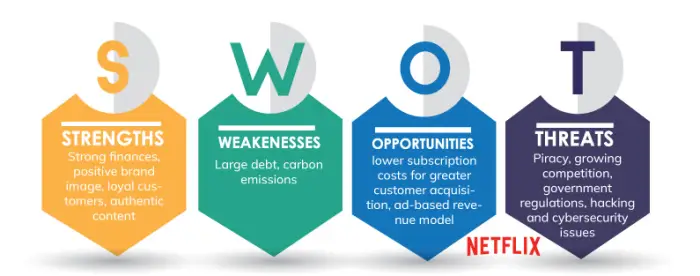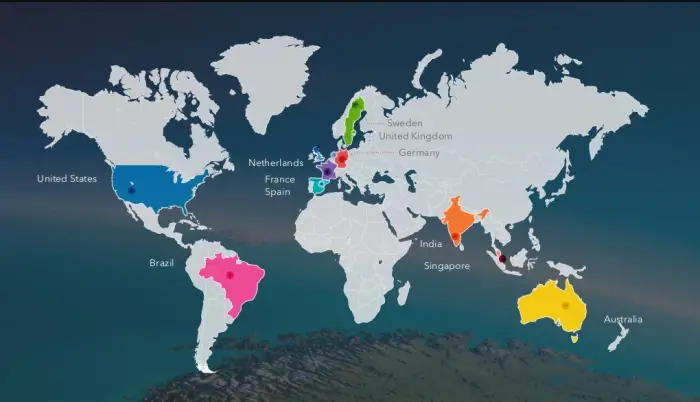Are you curious about the current state of Netflix and its potential threats in 2024? In this article, we will discuss a comprehensive SWOT analysis of Netflix, focusing on the threats it encounters.

Netflix SWOT Analysis in 2024: A comprehensive study of Netflix’s strengths, weaknesses, opportunities, and threats in the streaming industry. There are various threats to Netflix, which we will be discussing in this article.
Keep reading and discover the inner workings of Netflix as we analyze its strengths, weaknesses, opportunities, and threats.
See Also: A complete SWOT analysis of Asian Paints
About Netflix
Netflix is said to be one of the best streaming services and the most well-known company. According to the most recent numbers, which were collected in January 2024, there were more than 2300 Netflix users globally, which is rising. With Netflix, you may access any movie, television show, or documentary from anywhere in the world, and they can be found in more than 190 nations. Let’s start with Netflix’s SWOT analysis.
See Also: A Complete SWOT Analysis Of Swiggy
SWOT analysis of Netflix
Here is the complete Netflix SWOT analysis:
Netflix strength
Let us start Netflix’s SWOT analysis with its strength:
Influential brand
From 1997 to 2006, Netflix operated as a mail-based rental company before launching its services. However, they are currently one of the most significant streaming services, facing off against formidable rivals like Disney, Amazon Prime Videos, and others. Notably, it has significantly impacted the audience, as evidenced by the change from $1.36 billion in Revenue to over 26 million users.  As a result, it has developed into a well-known brand. With at least one or one subscriber in almost every home, Netflix has developed a strong brand identity.
As a result, it has developed into a well-known brand. With at least one or one subscriber in almost every home, Netflix has developed a strong brand identity.
Global Presence
The primary objective of Netflix is to amuse moviegoers with content in the form of movies, TV shows, documentaries, and more. Approximately 190 countries now provide Netflix and have content in roughly thirty languages.  Netflix is now unavailable in the following nations: Syria, North Korea, Crimea, and mainland China. They generate content for nations outside those already mentioned and are renowned for their exponential expansion.
Netflix is now unavailable in the following nations: Syria, North Korea, Crimea, and mainland China. They generate content for nations outside those already mentioned and are renowned for their exponential expansion.
See also : What is the Netflix Marketing Mix? 4Ps of Netflix’s Marketing Mix
Adaptability
Adaptability still falls within the “survival of the fittest” theory by Charles Darwin. In the case of Netflix, it is advantageous for the company to compete with strong rivals.  Still, it must adjust to several aspects to maintain its position as the finest streaming platform. They adopt a strategy that fits their context, monitor viewing habits, and modify their offerings accordingly.
Still, it must adjust to several aspects to maintain its position as the finest streaming platform. They adopt a strategy that fits their context, monitor viewing habits, and modify their offerings accordingly.
See also: SWOT Analysis of TCS (Tata Consultancy Services)
Weakness
Here is its weakness:
Limited Access
Those who want to watch a particular movie will get disappointed if they discover that it is unavailable in some areas.  Even if they serve nearly 190 nations, giving everyone access to all movies would be far better.
Even if they serve nearly 190 nations, giving everyone access to all movies would be far better.
Limited copyright
This is said to be one of the most effective ways to increase Revenue by obtaining copyrights, but it has limited copyright. As the statistics show, they have a debt of $13.888 billion, and last year they also faced a decline in subscribers of about 25%.
Subscription value and the lack of customer care executives
Unlike other platforms, Netflix does not have a rigid pricing strategy or more plan options. Now that other streaming services offer a 12-month plan and access to all devices, Netflix offers its customers the same plans and services, including mobile, basic, standard, and premium. No free Netflix option is available. As the business expands, it could deal with more customer complaints. They also should be responding to client inquiries as a business, but they need help to do so, lowering customer satisfaction.
As the business expands, it could deal with more customer complaints. They also should be responding to client inquiries as a business, but they need help to do so, lowering customer satisfaction.
Opportunities
As the market and people’s preferences change, companies or brands have no choice but to try to meet their demands to maintain their growth. Netflix has already established itself as an online streaming service with a good brand reputation. If they use the right opportunity, they will continue to be the best.
Ad-based content
Netflix advertisements are seen in several regions. However, if they include ad-supported films like in the prior miniseries, they will be similar to that YouTube and help to increase their Revenue.  They also stated in their 2022 announcement that the essential subscription with commercials would have 4-5 minutes of advertising every hour.
They also stated in their 2022 announcement that the essential subscription with commercials would have 4-5 minutes of advertising every hour.
Higher price
Many people have already begun canceling their subscriptions to Netflix services as it does not satisfy them. They can lower the prices for mobile streaming options like other streaming platforms, as that will increase the subscriber count.
Threats
These are the threats:
Their threats are their weaknesses
They have aggressive competitors like Amazon, Apple TV, and HBO. YouTube is the biggest threat to Netflix, as people even prefer to watch video content with ads, but they only show a little interest in Netflix, even though with ads, it will take more time.
Privacy and hacking of accounts
Because watching movies on Netflix is pricy, individuals watch or download them using a pirated version or another program instead, which poses a threat to all online streaming providers. The greatest danger facing streaming platforms is this.
The growing hacking of user accounts is a different problem that Netflix is dealing with, and they need to figure out a solution because a user needs to keep changing their password. These are Netflix’s SWOT analyses.
See Also: The SWOT Analysis of Nestle
FAQs
What is the strength of Netflix?
The primary objective of Netflix is to amuse moviegoers with content in the form of movies, TV shows, documentaries, and more. Approximately 190 countries now provide Netflix and have content in roughly thirty languages. Netflix is now unavailable in the following nations: Syria, North Korea, Crimea, and mainland China. They generate content for nations outside those already mentioned and are renowned for their exponential expansion.
What is the weakness of Netflix?
Many people have already begun to cancel their subscriptions to Netflix services because they are dissatisfied with them. They can lower the prices for mobile streaming options like other streaming platforms, as that will increase the subscriber count.
What are Netflix's threats?
They have aggressive competitors like amazon, Apple Tv, and HBO. YouTube is the biggest threat to Netflix, as people even prefer to watch video content with ads but only show a little interest in Netflix, though, with ads, it will take more time.
Conclusion
The Netflix SWOT analysis indicates that the organization should concentrate on its weaknesses to defend itself against potential threats in the future. Their vulnerability strengthens by continuing these policies, and they might highlight privacy, exclusive content, and other features to retain clients.
See Also: The SWOT Analysis of Zomato

